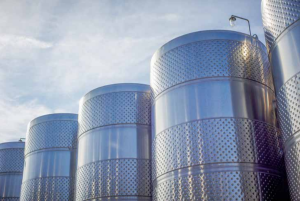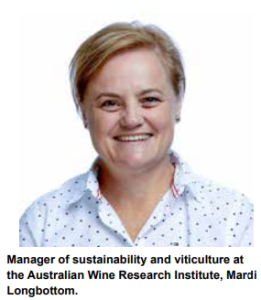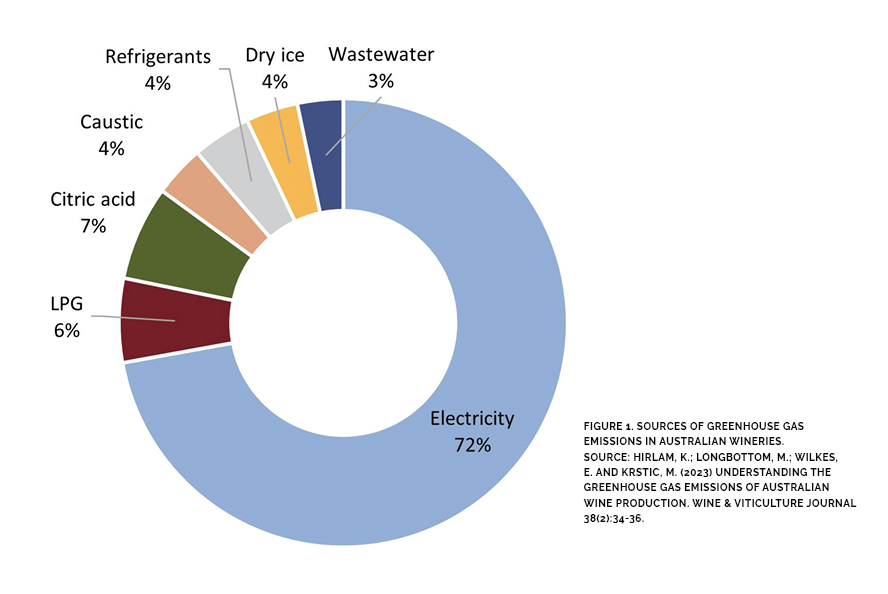By Adam Keath
Consultant, Wine Network Consulting, email: akeath@winenet.com.au
In this third article in our ‘Towards Net Zero’ series, Adam outlines the current options available to wineries to reduce their carbon outputs as the Australian wine industry endeavours to achieve its target of zero emissions by 2050.

Whilst the Australian wine industry is not a huge contributor to the country’s carbon emissions, it is not insignificant. Of Australia’s roughly 500 million tonnes of CO2e, our industry, including all its related supply chain including bottles and transport, contributes roughly two million tonnes. While that’s equivalent to around just 0.4% of our country’s emissions, it could also be smaller and as our overall emissions decrease across the board we must ensure that we follow suit to keep our green-ish image intact.
Scope 1 and 2 emissions in the winery can be considerable due to refrigeration and other energy-intensive tasks in production, but it is the Scope 3 emissions that add up quickly when we look into the effects of transporting grapes, wine and heavy dry goods like glass to and from wineries.
The push to reach net zero carbon emissions is gaining momentum. What was for a long time something considered the responsibility of governments is now seen as the responsibility of individual industries and businesses. Whilst consumers continue to want services and products that they have always enjoyed, there is now an expectation that those products are made in a sustainable way. Wine Intelligence recently reported that 65% of Australian wine drinkers prefer sustainably made wines. This is just one statistic that highlights the growing opportunities for businesses to change their practices and fit the market. Consumer expectations are high and authentic results are desired; any suggestion of ‘greenwashing’ can have the opposite effect and negatively impact business.
This is the third article in the ‘Towards Net Zero’ series, looking at ways to reduce carbon emissions within the Australian wine industry. Achieving this in the winery is essentially a three-step process:
- Understand your inputs completely. Where are the carbon-intensive parts of your business?
- Understand what can be done to minimise these emissions and costs.
- Understand what can be done with the remaining emissions – supplement with green energy or offset with other activities?
Recognising the common areas of high emissions in a winery and understanding what can be achieved through some simple and smart management of services is key to making practical and realistic changes. Further to this is then looking at the latest in carbon sequestration and how businesses can supplement their remaining carbon footprint with green energy and offsets that are auditable and have real outcomes.
The Greenhouse Gas Protocol (GHG Protocol) identifies three scopes of carbon reporting:
- Scope One – direct emissions from source, owned and controlled by a company
- Scope Two – indirect emissions from purchased electricity, steam, heat and cooling
- Scope Three – all other emissions associated with a company’s activities
It is important to identify key areas within the business that will have the largest impact, but it is worthwhile noting that it is the sum of all parts that makes the biggest difference. If the business is not committed to the measurement and control of all three parts of the [Greenhouse Gas Protocol], not just Scope One and Two, then gains made in the vineyard and winery will not significantly change your overall footprint.
Scope 1 and 2 are the easiest to measure and therefore the easiest to control and report on. They cover emissions released from owned and controlled assets, such as fuel used in company tractors, forklifts and cars, gas burnt in boilers and fugitive emissions like refrigerant leaks and spills. Scope 2 covers indirect emissions from purchased electricity. It is Scope 3 however, that gets more complicated and can be difficult to calculate and understand. Transport emissions, both upstream and down, can be influenced heavily by decisions made in the winery and to a greater extent, the marketing and sales departments.
Product packaging and transport can have a significant impact on your carbon footprint depending on the weight of the glass bottles, where they are produced and the delivery methods used, for both goods receival and outgoing products. Changes at this stage of operations can have a larger effect than by trying to make reductions in other areas, for instance, limiting tractor passes in the vineyard. For example, according to the carboncare.org emissions calculator, transporting a full glass 2.5kg bottle of wine via air freight from Melbourne to London (17,000km) will contribute 35kg of CO2 emissions to your footprint, whereas a full eco lightweight design bottle (1.2kg) sent via boat will only contribute 0.2kg of CO2 emissions. The average density of Australian vine rows is 3.17km/ha, so a tractor travelling at 7.5km/hr will produce, on average, 3.8kg CO2 emissions per hectare per pass. This divided over the potential 9000 bottles produced from that hectare is negligible (0.4 grams) when compared to that of transporting heavy glass by plane.
It is important to identify key areas within the business that will have the largest impact, but it is worthwhile noting that it is the sum of all parts that makes the biggest difference. If the business is not committed to the measurement and control of all three parts of the GHP Protocol, not just Scope One and Two, then gains made in the vineyard and winery will not significantly change your overall footprint.
Management expert Peter Drucker once said, “what gets measured, gets managed” and nothing could be more accurate when trying to reduce your carbon emissions. This is particularly relevant when undertaking the first step towards this goal, understanding your business’ current state and determining a benchmark to measure against in the future.
There are many tools and services available to help measure your emissions, but it is important to compare like with like by ensuring that the model you use includes the same scope of emissions, allowing for direct and accurate comparison. For this reason, we actively support the use of a single industry-wide program – Sustainable Winegrowing Australia (SWA). Collectively managed by Australian Grape and Wine, Wine Australia and the Australian Research Institute (AWRI), the program is designed to help create a socially, environmentally and economically resilient business and gain nationally-recognised certification. SWA provides a platform for its members to record all their inputs, including energy, water and transport, enabling wineries to track and report on their Scope One and Two emissions. The ongoing benefit of the program is that as more wineries join and gain accreditation, the more accurate and useful the benchmarking tools become.
Knowing how you compare in various areas to other wineries allows you to understand where to focus your attention first in order to make the most significant gains. Whilst the initial phase has been about getting the industry onboard – a task that seems to be progressing well with a 48% increase in members in 2022 – the program, after three years of operation, now covers 804 vineyards, representing 37% of Australia’s total vineyard area, and 113 wineries, representing 41% of Australia’s wine production.
All members are required to input data on their energy and waste, allowing SWA to determine and report not only on all Scope One and Two emissions, but also some Scope Three emissions. The program also acts as a survey to determine, in a less quantitative manner, what the industry is interested in and focusing on. From current member data, SWA has identified that 79% of participating vineyards are taking active measures and are prioritising energy-efficient practices in the vineyard. It also shows that 85% of wineries have prioritised energy efficiency for new plant and equipment. These insights are important in helping to promote and highlight the positive changes that are happening within the wine industry.
Whilst membership is based on self-reporting, to become a certified member and display the SWA trust mark on their products and marketing materials, wineries, vineyards and wine businesses are required to undertake an independent audit against the Australian Wine Industry Standard of Sustainable Practice. The involvement of companies such as Treasury, Pernod Ricard Winemakers and Yalumba indicate that there is value in participating in the program, both ethically and commercially.

The AWRI’s manager of sustainability and viticulture, Mardi Longbottom, confirmed this strategy: “A critical first step is to measure and calculate your emissions to understand your own site’s emissions profile. You can then target where your emissions can be decreased and track your progress”.
It may look simple but once understood, a plan can be made to minimise each of the inputs.

Electricity is by far the largest contributor to a winery’s emissions, as show in Figure 1 and though an easy option would be to supplement with green energy from the grid, there is an opportunity to look into what this number comprises and what can be done to reduce it.
The largest contributor to this number in most Australian wineries is refrigeration. It is commonly reported that up to 70% of a winery’s energy use will be from refrigeration.
Winery software system VinWizard uses specific inbuilt features that can be used to help reduce wineries’ energy uses. Kelly Graves, the CEO if Wine Technology Incorporated, which owns VinWizard, explained the benefits of using this kind of technology.
“Having previously worked for one of the world’s largest wine producers in a role which focused on cost savings and margin expansion through the use of better technology, I can confidently say that few automation platforms take direct aim at reducing energy consumption like VinWizard has,” she said.
“When evaluating the merits of automating areas of wine production, my belief is there should always be a demonstrable beneficial financial impact for the winery. The most discrete and easily confirmed means of cost savings arises from reducing the amount of energy consumed. Every winery has a line item on their P&L for utilities; when we can point to that specific line item and show that it decreases, it’s a win for both VinWizard and the winery.”
Graves identified four key features of the software that help drive a reduction in energy and emissions:
LOAD SCHEDULING
This can take many forms, but the major gains come from shifting the bulk of chilling from day to night. As refrigeration plants are essentially just transferring heat from once place to another, that transfer happens more efficiently at night when ambient temperatures are lower. The main idea is to manipulate the situation so that the call for cooling is moved to a time when the plant can operate at its most efficient. By allowing a tank to be chilled by an additional one to two degrees at night time, so that it requires no cooling during the day, will result in less energy being used. It also has the added benefit of consuming power during the off-peak period, which is the cheapest time of the day.
It means that the chiller operates for less hours of the day, but in a more efficient way. Whilst this will not always work in every situation, for example, during vintage with ferments, having the ability and logic to identify those tanks can be treated like this can make a significant difference. It allows additional cooling capacity during the day to manage additional incoming fruit chilling, managing more fruit with less capacity. It has been demonstrated that a 25-35% reduction in power use can be accomplished with this strategy.
AUTOMATIC ADJUSTMENT
Automatically adjusting cooling setpoints is another way VinWizard can save energy. With the ability to talk to the refrigeration plant, you can set up the program to change the cooling setpoint of the secondary refrigerant, based on the setpoints in the winery. Outside of vintage, if you are trying to maintain tanks at 10˚C, you don’t need the glycol to be at -6˚C or -8˚C.
Many wineries manage this manually by changing the setpoints based on what is happening in the winery, but this normally happens in blocks of time and doesn’t take full advantage of the savings available. The cost increases can be around 2.5% for every degree colder the coolant is maintained at, so in the example above if your glycol temp was at 4˚C instead of -6˚C the net saving could be as high as 25%.
PULSE COOLING
The principle of this process, which has been trialled and tested at the University of California, Davis, by Roger Boulton, is to fill the jacket with cold glycol and stop the flow to allow the heat transfer from the juice. When the glycol is close to the juice temperature, the jacket is filled with glycol again and so on while the juice is above setpoint. The benefits to the wine and the power savings potential include, but are not limited to, the following:
- no ice build-up on the inside or outside of the tank so heat transfer is more efficient
- the return glycol is warmer than normal and will be returned to the chiller in bursts, so the chiller works more efficiently to bring it back down to temperature
- the glycol is stationary when it does its work, which is more efficient than having a constant flow
- the fluctuations in temperature cause convection in the tank, which helps mix the product (less expensive than installing agitators)
- the glycol does not need to be as cold, as the heat transfer is more efficient
PUMP CONTROL
Running brine circulation pumps at full power, 24 hours a day, is simply a waste of energy. Running variable speed drives (VSD) and even controlling VSD setpoints based on load, can significantly reduce the power needed for this function.
FURTHER REDUCTIONS
Other energy-intensive tasks in the winery include waste water management, aerating ponds or reactors with blowers at full speed, with no feedback loop to dissolved oxygen, which all result in a large amount of wasted energy. Like refrigeration, any energy-intensive task that can be monitored and regulated will result in large cost savings and aid in reaching your targets.
With some careful investment, a winery can reduce their power consumption by up to 50%, significantly decrease their carbon footprint and achieve a more sustainable business with reduced operating costs.
Another area identified in Figure 1 that can have a significant impact on emissions is CO2. This refers to CO2 purchased and used in the process of making wine. What is not identified on any carbon footprint calculation is the CO2 emitted by a winery during fermentation as it is considered offset by the growing of the grapes (cyclic). This is technically the largest direct CO2 emission from wineries, with every tonne of fermented grapes releasing around 100kg of CO2, the equivalent of around 50,000 litres. If you were able to capture and reuse or export this CO2, a positive credit could be applied to a winery’s carbon footprint.
 Simon Nordestgaard, Principal Engineer at Affinity Labs, is a keen observer of this space and when speaking with him, he pointed out that the capture and reuse of CO2 is much more common in the brewing industry as ferments are conducted all year round. That being said, the conversation in the wine industry is gaining traction, with more support and attention being directed towards this area. Nordestgaard noted that the upcoming Winery Engineering Association conference (WINE ENG 2023, 26-27 July, Barossa Valley) will have three speakers discussing this topic.
Simon Nordestgaard, Principal Engineer at Affinity Labs, is a keen observer of this space and when speaking with him, he pointed out that the capture and reuse of CO2 is much more common in the brewing industry as ferments are conducted all year round. That being said, the conversation in the wine industry is gaining traction, with more support and attention being directed towards this area. Nordestgaard noted that the upcoming Winery Engineering Association conference (WINE ENG 2023, 26-27 July, Barossa Valley) will have three speakers discussing this topic.
Jean-Philippe Ricard, from CO2 Winery in France, will share his experience of working with wineries to capture and reuse CO2, Laurent Fargeton, from Vivelys, will talk about its Scalya’UP system that uses captured CO2 to mix ferments; and Frank McCormack from Coopers, will discuss his experiences with CO2 reuse systems in breweries.
CO2 Winery offers a suite of different solutions for reusing CO2. It has systems at two wineries in Bordeaux – Chateau Montrose and Smith Haute Lafite – that capture the CO2 from ferments and convert it into potassium or sodium bicarbonate for sale. At other wineries they are compressing CO2 for later use, adding it to water to reduce the volume required for rinsing, using it for tank agitation or to slightly reduce alcohol levels.
Removing the need to purchase bulk CO2 for inerting purposes in a winery can remove 5-10% of CO2 emissions reported at the winery. The difficulty of this process is managing the storage of something that is only generated at one time of the year.
Once a winery has reduced its inputs, it can then look into how the remaining CO2 emissions can be removed through the use of green energy. Whether this is generated on site or purchased through agreements with others, it is an option that requires further consideration.
The main objective to keep in mind when planning to reduce carbon emissions is to focus on what is manageable and achievable. It is important to investigate and consider all areas of the business, not just what is visible in the winery. Being aware of the impact of things such as packaging, mode of transport and even the impact of international promotional travel, can affect your footprint and ability to reach your targets.
Focusing on one area alone, like power consumption and its source, whilst still beneficial and worthwhile, is not going to enable you to achieve net zero in the winery. Consumer behaviour is now heavily influenced by a business’s ethical and environmental standards, but it is unwise to promote these practices if they are not consistent across all areas of the business.
Using resources like SWA and integrated systems in the winery that allow you to measure and adjust as you go are incredibly useful tools that are both easily accessible and user-friendly. It also shows where the Australian wine industry is heading and the commitment to working together to achieve a more sustainable and environmentally responsible industry.
It can seem overwhelming to many businesses to begin the process of assessing and implementing changes to reduce their carbon footprint, but with the right tools and support it is absolutely achievable and will improve the business long-term. The most important part is to start somewhere. Any changes that improve sustainability and reduce your carbon footprint are positive changes.
Published in the Wine & Viticulture Journal, Winter 2023 edition.